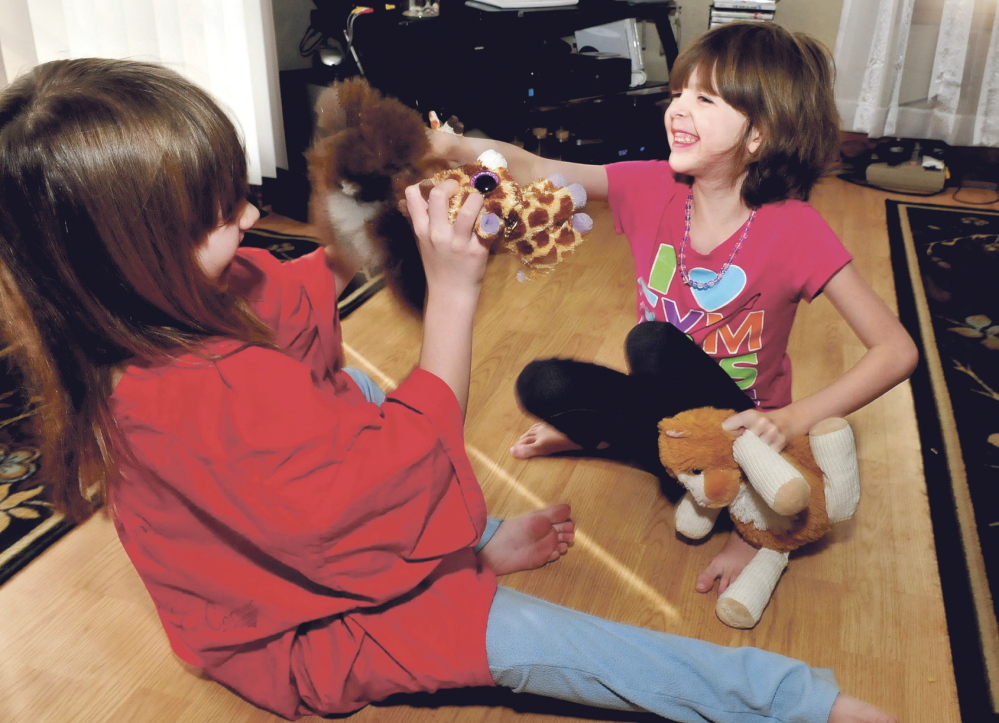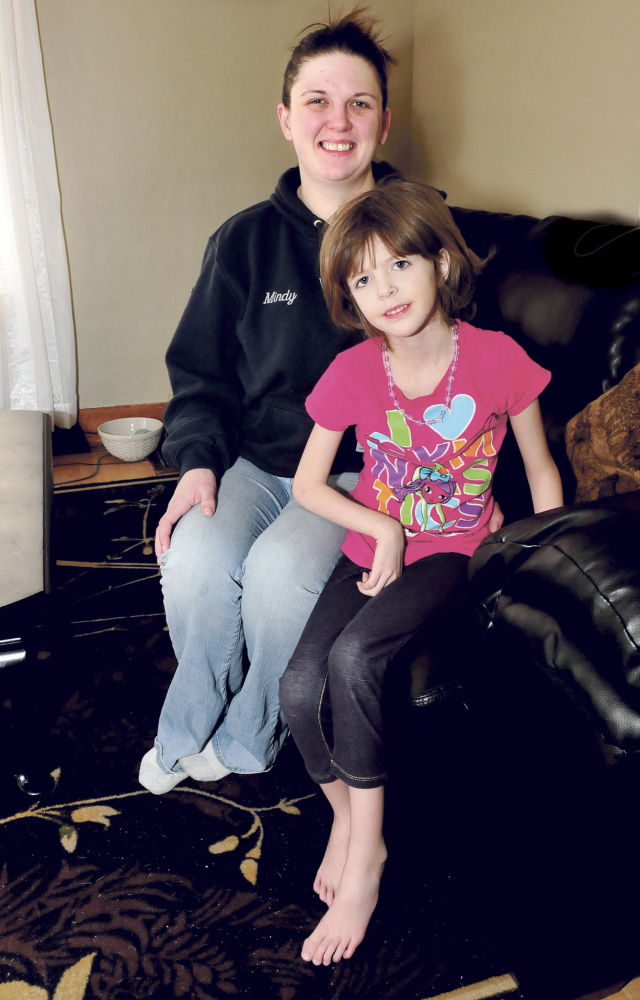The girl was unusually skinny. Standing in line for a water ride at Funtown Splashtown USA in Saco last summer, the 5-year-old’s ribs were clearly visible.
“She does look malnourished,” said her mother, Mindy Parker, of Augusta.
But when a group of young adults started making snide comments about her weight, Parker said her daughter, Kaitlyn, wasn’t shy about educating them.
“My daughter, she is very outspoken, and she’s the one who explained it to them,” Parker said. “She told them she has a boo-boo on her heart, and she tried to give them a lot of details.”
The incident, initially uncomfortable, developed into a conversation between Parker and the young adults in which they learned about the girl’s condition, Marfan syndrome.
Marfan, a rare genetic disorder, creates an unusual problem for the medical community. When it is diagnosed, it can usually be controlled with interventions; but when it goes undetected, it can be deadly. It occurs in only one out of 5,000 people, so there is no routine screening to catch the disorder, meaning those who have it often don’t realize it until it is too late.
A new group is forming in central Maine to help raise awareness of the disorder, which often can be recognized simply by looking at a person. Parker and about 20 others who are grappling with Marfan and related disorders are coming together Monday night for the first time at The Red Barn in Augusta to share information, support and strategies about how to increase public awareness.
People with Marfan, such as Kaitlyn, are born with an abnormality in the gene that produces fibrillin-1, an important component of the body’s flexible connective tissue. The defect causes the body to produce high levels of something called “transforming growth factor beta,” a protein that can wreak havoc on the eyes, the lungs, the joints and the heart.
Because many Marfan sufferers have a specific body type, failures to diagnose it are more frustrating for those who are trying to raise awareness about the condition.
People with Marfan tend to have a tall, lean frame, long fingers and elongated facial features. Some historians believe Abraham Lincoln might have had Marfan.
Other people have a large number of physical markers, which can include crowded teeth and a sunken chest, when they are young. In others, features may develop over time, and not appear until adulthood, if ever.
“Many people go through their whole life without knowing that they have it,” Parker said.
That’s a problem, because awareness of having Marfan gives a person a much better chance of living a long, healthy life, according to The Marfan Foundation, a national organization founded in 1981 to help people with the disorder.
Parker is looking for more ways to spread the word about Marfan so that more people can get help before it’s too late.
When the new support group convenes, it won’t be limited to those with Marfan.
Marfan is one of a whole cluster of related conditions, many of which have similar effects on the people who have them. One, Loeys-Dietz syndrome, is characterized by widely spaced eyes and a cleft palate.
Another, Ehlers-Danlos syndrome, is best known for its characteristic traits of extremely flexible joints and unusually elastic skin. A handful of Ehlers-Danlos sufferers have gone on to careers as circus performers.
Other related disorders recognized by the Marfan Foundation include Beals syndrome, Stickler syndrome and Mass phenotype, all of which have similar causes and symptoms.
Parker said it’s important for those with Marfan to realize that they are not alone and to be able to connect with others who share some of their experiences.
DIAGNOSING MARFAN
Every person who has Marfan and knows it has a story about how it was first diagnosed.
Kaitlyn has had the characteristic body type since birth, but at first no one realized she had Marfan.
“She’s always been very long and skinny for her age,” Parker said.
When Kaitlyn was 8 months old, she came down with pneumonia, which left her sick and dehydrated. While treating her for that, doctors first noticed a heart murmur and referred her to a cardiologist, who helped to make the diagnosis.
If it hadn’t been for the bout with pneumonia, Parker said, it might have taken much longer for doctors to realize she had Marfan.
“I had never heard of it,” Parker said.
Parker said the potential for health complications and the realization that her daughter might draw stares from strangers, as she did at the water park this summer, worried her.
“My daughter handles those situations better than I do,” Parker said. “A mother doesn’t want to see anything bad happen to her children.”
Kaitlyn’s heart murmur was being caused by her mitral valve, which controls the flow of blood between two of the four chambers of the heart.
“In the long term, she is definitely going to need surgery,” Parker said. “She’s so young, we’re trying to put it off.”
For Gary Bennett, 62, of Oakland, being diagnosed with Marfan was a fluke, but it saved his life.
Bennett, who is also involved with Parker’s support group, doesn’t have the unusual body shape and other physical characteristics of Marfan, so he had no reason to suspect he might suffer from it. When his father died suddenly in 1973 at the age of 50, the doctors told his family a heart attack was the cause.
One of the ways in which Marfan can kill someone involves the aorta, the large blood vessel that carries blood away from the heart. In most people, there is some elasticity to the aortic wall, which helps it to expand and contract with the flow as the heart pumps blood throughout the body. The Marfan Foundation says that nine out of 10 people with Marfan experience cardiovascular problems. For many people with Marfan, the vessel loses its elasticity, meaning it becomes larger over time, with increasingly thin walls. At some point, the thin wall ruptures, which can lead to a quick death often misdiagnosed as a heart attack.
In the 1990s, Bennett was struck by an article in Men’s Health Magazine that recommended that everyone review their parents’ medical conditions and autopsy results. When Bennett’s current doctor noticed that his father had had an unusually large aorta, it touched off a chain of events that eventually led Bennett to have surgery that corrected his own previously unknown heart problems.
Because Marfan affects such a small percentage of the population, it’s impractical to test everyone for the condition. But being sensitive to clues that it is present — a heart murmur; physical features such as long, thin arms; a red flag in a parent’s medical report — can help diagnosis and lead to early help.
GROWING UP
Today, Kaitlyn, who stands four feet tall and weighs just 27 pounds, is learning what it means to grow up with Marfan.
Kaitlyn’s thinness isn’t for lack of appetite. “She eats like a pig,” Parker said.
With a potential surgery still years away, she is on medication, which controls her symptoms and which have produced no troubling side effects.
“I don’t want her to use it as a crutch,” Parker said. “I want her to have a normal life.”
In many ways, Kaitlyn is indistinguishable from other girls her age. She loves the cartoon character Dora the Explorer and refers to pop star Justin Bieber as her boyfriend.
“She’s outgoing and smart,” Parker said. “She’s a personality of her own.”
But for Kaitlyn, there are more limits than for most people. She makes frequent trips to the doctor and keeps her physical activities in check.
“She know when she needs to rest. She handles all the doctors very well,” Parker said. “She’s been pretty good with it.”
She also has respiratory problems, caused because her body is less effective at keeping fluids out of her lungs.
Her eyesight has not been affected, however, and her peers and teachers at Sylvio Gilbert Elementary School in Augusta, where she is a pre-kindergarten student, accept and support her.
Partially because she was diagnosed early and will grow up in a family in which her mother is plugged into the Marfan support community, her story has a better chance of having a happy outcome.
“Long-term, she has a pretty good life ahead,” Parker said.
Matt Hongoltz-Hetling — 861-9287 mhhetling@centralmaine.com Twitter: @hh_matt
Send questions/comments to the editors.




Success. Please wait for the page to reload. If the page does not reload within 5 seconds, please refresh the page.
Enter your email and password to access comments.
Hi, to comment on stories you must . This profile is in addition to your subscription and website login.
Already have a commenting profile? .
Invalid username/password.
Please check your email to confirm and complete your registration.
Only subscribers are eligible to post comments. Please subscribe or login first for digital access. Here’s why.
Use the form below to reset your password. When you've submitted your account email, we will send an email with a reset code.